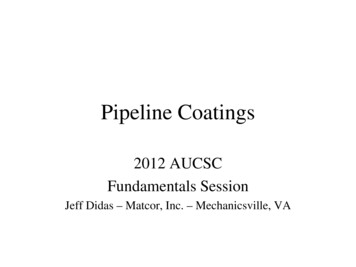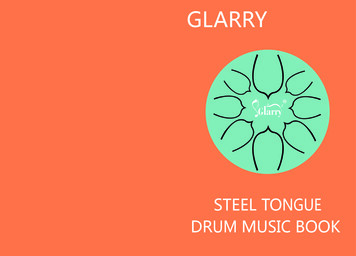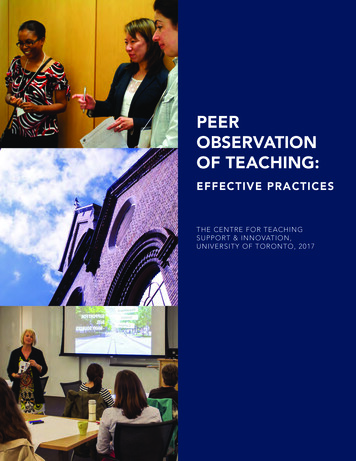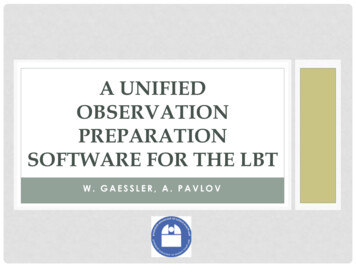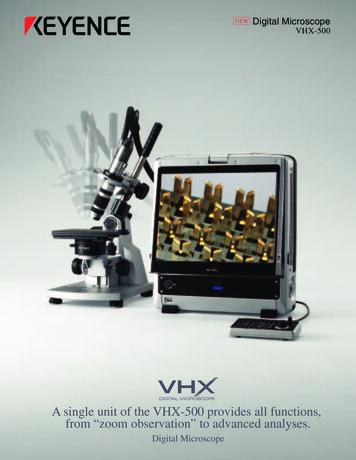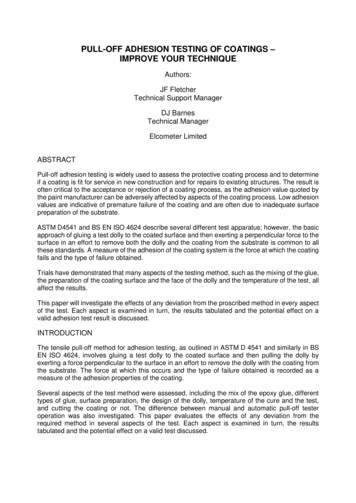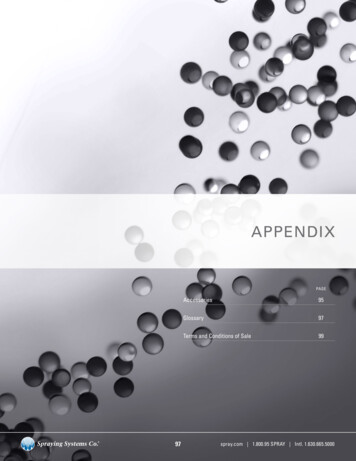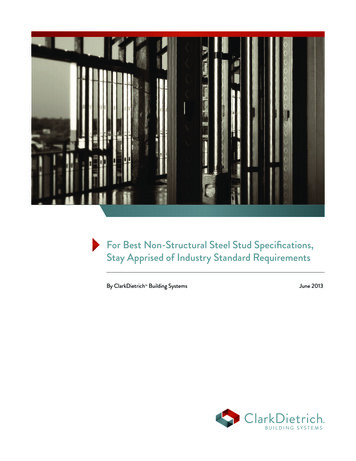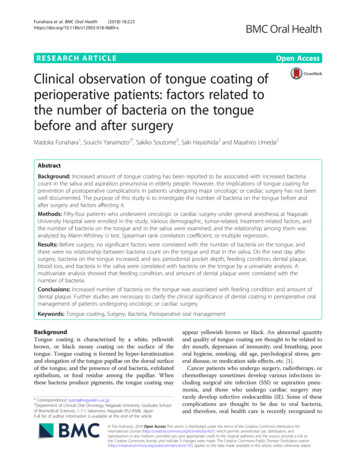
Transcription
Funahara et al. BMC Oral Health(2018) EARCH ARTICLEOpen AccessClinical observation of tongue coating ofperioperative patients: factors related tothe number of bacteria on the tonguebefore and after surgeryMadoka Funahara1, Souichi Yanamoto2*, Sakiko Soutome3, Saki Hayashida2 and Masahiro Umeda2AbstractBackground: Increased amount of tongue coating has been reported to be associated with increased bacteriacount in the saliva and aspiration pneumonia in elderly people. However, the implications of tongue coating forprevention of postoperative complications in patients undergoing major oncologic or cardiac surgery has not beenwell documented. The purpose of this study is to investigate the number of bacteria on the tongue before andafter surgery and factors affecting it.Methods: Fifty-four patients who underwent oncologic or cardiac surgery under general anesthesia at NagasakiUniversity Hospital were enrolled in the study. Various demographic, tumor-related, treatment-related factors, andthe number of bacteria on the tongue and in the saliva were examined, and the relationship among them wasanalyzed by Mann-Whitney U test, Spearman rank correlation coefficient, or multiple regression.Results: Before surgery, no significant factors were correlated with the number of bacteria on the tongue, andthere were no relationship between bacteria count on the tongue and that in the saliva. On the next day aftersurgery, bacteria on the tongue increased, and sex, periodontal pocket depth, feeding condition, dental plaque,blood loss, and bacteria in the saliva were correlated with bacteria on the tongue by a univariate analysis. Amultivariate analysis showed that feeding condition, and amount of dental plaque were correlated with thenumber of bacteria.Conclusions: Increased number of bacteria on the tongue was associated with feeding condition and amount ofdental plaque. Further studies are necessary to clarify the clinical significance of dental coating in perioperative oralmanagement of patients undergoing oncologic or cardiac surgery.Keywords: Tongue coating, Surgery, Bacteria, Perioperative oral managementBackgroundTongue coating is characterized by a white, yellowishbrown, or black mossy coating on the surface of thetongue. Tongue coating is formed by hyper-keratinizationand elongation of the tongue papillae on the dorsal surfaceof the tongue, and the presence of oral bacteria, exfoliatedepithelium, or food residue among the papillae. Whenthese bacteria produce pigments, the tongue coating may* Correspondence: syana@nagasaki-u.ac.jp2Department of Clinical Oral Oncology, Nagasaki University Graduate Schoolof Biomedical Sciences, 1-7-1 Sakamoto, Nagasaki 852-8588, JapanFull list of author information is available at the end of the articleappear yellowish brown or black. An abnormal quantityand quality of tongue coating are thought to be related todry mouth, depression of immunity, oral breathing, poororal hygiene, smoking, old age, psychological stress, general disease, or medication side effects, etc. [1].Cancer patients who undergo surgery, radiotherapy, orchemotherapy sometimes develop various infections including surgical site infection (SSI) or aspiration pneumonia, and those who undergo cardiac surgery mayrarely develop infective endocarditis (IE). Some of thesecomplications are thought to be due to oral bacteria,and therefore, oral health care is recently recognized to The Author(s). 2018 Open Access This article is distributed under the terms of the Creative Commons Attribution 4.0International License (http://creativecommons.org/licenses/by/4.0/), which permits unrestricted use, distribution, andreproduction in any medium, provided you give appropriate credit to the original author(s) and the source, provide a link tothe Creative Commons license, and indicate if changes were made. The Creative Commons Public Domain Dedication o/1.0/) applies to the data made available in this article, unless otherwise stated.
Funahara et al. BMC Oral Health(2018) 18:223be important during cancer therapy or cardiac surgery[2–4]. It has been reported that increased amount oftongue coating is associated with increased bacteria inthe saliva and aspiration pneumonia in elderly people[5, 6]. However, the implications of tongue coatingand the necessity of removing it in cancer patientsduring treatment have not been well documented. Asa first step to respond to these questions and to establish standardization of oral care for perioperativepatients, we decided to investigate whether bacteriaon the tongue increased after major oncologic or cardiac surgery and what factors influenced the numberof bacteria on the tongue.MethodsThe study is a prospective, observational study comprising 54 patients who underwent surgery for cancer orheart disease at Nagasaki University Hospital betweenJanuary and March 2017 (Fig. 1). Patients who did notperform dental examinations or oral care describedbelow were excluded. After written informed consentwas obtained from each patient, the following factorswere examined: 1) patient-related factors (age, sex, bodymass index, performance status [PS], diabetes, smokinghabit, and drinking habit); 2) laboratory data (preoperative serum creatinine, alanine aminotransferase, andalbumin); 3) treatment-related factors (indication forsurgery, operation time, and blood loss during surgery);and 4) oral condition (amount of dental plaque,Page 2 of 8maximum periodontal pocket depth before surgery,feeding condition on the day after surgery, oral wetness,and number of bacteria in the saliva and on the tonguebefore and after surgery).PS was categorized as PS 0 to PS 4 according to theEastern Cooperative Oncology Group classification [7].The amount of dental plaque was defined as the O’Learyplaque score [8] number of the teeth. Oral wetnesswas measured at the surface of the buccal mucosa usingan oral hydrometer (Moisture Checker Mucus , Life Co.,Ltd., Saitama, Japan). The number of bacteria on thetongue and in the saliva, was measured according to apreviously reported method [9, 10] with a rapid oral bacteria quantification system (Panasonic Healthcare Co.Ltd., Osaka Japan) using the dielectrophoresis and impedance measurement methods.Each patient received standard oral care from a dentistand dental hygienist. Oral care was started from the timethe decision for hospitalization was made. It includedoral health instruction, removal of dental calculus (scaling), professional mechanical tooth cleaning (PMTC),removal of tongue coating with toothbrush, cleaningdenture, and extraction of tooth with severe periodontitis. All patients received final oral cleaning by a dentistor dental hygienist the day before surgery.Statistical analyses were performed using SPSS software (version 24.0; Japan IBM Co., Tokyo, Japan). Univariate analysis of the relationship between each variableand number of bacteria on the tongue was analyzed81 patientswho underwent major oncologic or cardiac surgery fromJanuary 5 to March 31, 201727 patientswho did not receive dentalexaminations and oral carewere excluded54 patientsEligible patientsOral care: 2016.12 15 – 2017.3.30Surgery: 2017.1.5 – 3.31Data collection : 2017.1.4 – 4.1Fig. 1 Flowchart of the study design
Funahara et al. BMC Oral Health(2018) 18:223Page 3 of 8Table 1 Background factors of the patientsTable 1 Background factors of the patients (Continued)VariableCategorymean SD ornumberVariableGendermale32female22the saliva before surgery(logarithm)AgeDisease67.4 14.5 yearsprostatecancer1pancreaticcancer1liver cancer2kidney cancer2head andneck cancer4colorectalcancer5breast cancer5other cancers5gastric cancer7lung cancer11heart disease11BMIPS22.0 3.33PS043PS17CategoryNumber of bacteriain the saliva after surgery(logarithm)6.61 0.91Number of bacteria onthe tongue before surgery(logarithm)6.75 0.601Number of bacteria onthe tongue after surgery(logarithm)6.88 0.66using the Mann–Whitney U test and Spearman rankcorrelation coefficient. Multivariate analysis was conducted using stepwise multiple regression analysis. Thedifferences among number of bacteria on the tongue before oral care, after oral care, and after surgery were analyzed using the Mann–Whitney U test. The correlationbetween number of bacteria on the tongue and that inthe saliva was analyzed by the Spearman rank correlation coefficient. Probabilities of less than 0.05 were accepted as significant.Ethical approval was obtained from the InstitutionalReview Boards (IRB) of Nagasaki University Hospital(No. 16031420).PS24–45 9ResultsSmoking habitwithin one year–48Characteristics of the patients 6Drinking habitwithin one year–41 13DiabetesCreatinine0.834 0.260 mg/dLALT23.5 18.1 IU/LAlbumin4.05 0.625 g/dLAmount of dentalplaque492.45 383.17Periodontal pocketdepthedenturous6 6 mm39 6 mm9Oral wetness beforesurgery26.1 2.94Oral wetness aftersurgery23.7 5.08Operation time278 177 minBlood loss411 775 gFeeding condition onthe next day after surgeryNumber of bacteria innormal food10stop feeding38intubation65.54 0.52mean SD ornumberTable 1 shows background factors of the patients.Thirty-two patients were males and 22 females, withan average age of 64.7 years. Oncologic surgery wasperformed in 43 patients and cardiac surgery in 11.Ten patients fed orally at the next day of surgery,while 38 were fasted and 6 were under intubation.Correlation between number of bacteria on the tongueand that in the salivaFig. 1 shows the correlation between bacteria counton the tongue and that in the saliva before oral careon the day before surgery. No significant correlationwas found between them. However, there was significant correlation in number of bacteria on the tongueand that in the saliva on the day after surgery(Fig. 2).Number of bacteria on the tongue and factors affecting itbefore and after surgeryThe number of bacteria on the tongue ranged from105.00 to 107.89 cfu/mL before surgery. The univariateanalysis showed that no variable examined in the studywas significantly correlated with the number of bacteriaon the tongue before surgery (Table 2). The multivariate
Funahara et al. BMC Oral HealthA(2018) 18:223Page 4 of 8BCFig. 2 Macroscopic features of the tongue coating. a Before oral care, b After oral care, c After surgeryanalysis also showed no significant factors correlatedwith number of bacteria on the tongue (data notshown).On the day after surgery, most patients showed a larger number of bacteria on the tongue, ranging from105.71 to 108.00 cfu/mL. The univariate analysis indicatedthat patient sex, periodontal pocket depth, feeding condition, and the number of bacteria on the tongue beforesurgery were significantly correlated with the number ofbacteria on the tongue after surgery (Table 3). Multipleregression analysis showed feeding condition andamount of dental plaque to be independent significantfactors related to the bacteria count on the tongue(Table 4).Perioperative changes of number of bacteria on thetongue according to feeding conditionOn macroscopic inspection, most patients showedthicker tongue coating after surgery (Fig. 3). demonstrates the number of bacteria on the tongue beforeand after surgery. After preoperative oral care, bacteria count was significantly reduced, but on the dayafter surgery, it increased again. The degree of increase was the smallest in patients who ate normalfood immediately after surgery, intermediate in thosewho were fasting the day after surgery, and largest inintubated patients.DiscussionIn elderly people need in care, pneumonia is mostly believed to be caused by aspiration of pathogenic microorganisms in the saliva, as well as swallowing disorderand depressed immunity [11]. Some authors indicatethat bacteria in the dental plaque or periodontalpockets is a reservoir for oral bacteria and, therefore,may become one of the major causes of aspirationpneumonia [12, 13]. There are various methods forevaluating the state of oral hygiene, and we used theamount of dental plaque as the O’Leary plaque score number of the teeth in the study. Other evaluationmethods such as Oral hygiene index- debris index(OHI-DI) [14] are also useful, but since the number ofsamples in this study is small, we focused on quantifying detailed plaque and used the O’Leary plaque score number of the teeth. However, occurrence rate ofpneumonia did not differ between dentulous and edentulous elderly patients need in care [11], which indicates that neither dental plaque nor periodontal diseaseis the main cause of aspiration pneumonia in the elderly. In contrast, Abe et al. [5] reported that tonguecoating is associated with number of viable salivarybacterial cells and the development of aspiration pneumonia, and that tongue coating is a risk indicator of aspiration pneumonia in edentate elderly people innursing homes. Additionally, Ryu et al. [6] have reported a relationship between tongue coating status, aswell as salivary flow rate, denture plaque, and frequencyof oral self-care, and number of oral anaerobic bacteria;however, the implication of tongue coating in perioperative patients has not been well documented.Hayashida et al. [10] reported that tongue coating inintubated patients increased immediately after surgery,although dental plaque did not. We examined the number of bacteria in various sites of the oral cavity duringsurgery under general anesthesia, and found that bacteria on the dorsum of the tongue rapidly increased immediately after intubation but, at surfaces of the buccalmucosa and the palate, the number of bacteria did notchange during surgery [9]. These findings suggest thatthe dorsal tongue environment is suitable for bacterialgrowth, especially when self-cleaning functions are reduced due to suppression of the swallowing function.In Japan, oral care by dentist and dental hygienist before and after majora oncologic or cardiac surgery hasbeen covered by public medical insurance system since2012, and it was called as “perioperative oral management”. Perioperative oral management aims to preventvarious complications such as SSI, postoperative pneumonia, IE, and oral mucositis during cancer therapy orcardiac surgery by reducing oral bacteria. There are twopossible mechanisms by which oral bacteria areinvolved in these complications: direct exposure of
Funahara et al. BMC Oral Health(2018) 18:223Page 5 of 8Table 2 Correlation between each variable and bacteria on the tongue before surgeryaMann–Whitney U-testSpearman rank correlation coefficientbbacteria in the saliva and hematogenous infection todistant sites from infection lesion in the oral cavity.Therefore, it is important not only to eliminate infection foci in the oral cavity, but also to reduce the number of saliva bacteria in the perioperative period. Thestudy suggests that tongue coating is one of the mainreservoirs of bacteria in the saliva, but it has not beeninvestigated whether the number of bacteria in the saliva will decrease if tongue coating is removed.We undertook this study in an attempt to establishstandardization of oral care for perioperative patientsto prevent postoperative complications such as surgicalsite infection and postoperative pneumonia. Most patients underwent oral care before and after surgery,which consisted of tooth brushing, scaling, professionalmechanical tooth cleaning, and gargling; removal oftongue coating is not included in the standard oralcare. The current study showed that the number ofbacteria on the tongue was significantly correlated withthat in the saliva the day after surgery, while there wasno correlation between them before surgery. The difference in the preoperative and postoperative results is
Funahara et al. BMC Oral Health(2018) 18:223Page 6 of 8Table 3 Correlation between each variable and bacteria on the tongue after surgerymeans p 0.05 and ** means p 0.01Mann–Whitney U-testbSpearman rank correlation coefficient*athought to be due to disorder of self-cleaning functionsof the oral cavity after surgery, probably because ofswallowing dysfunction and postoperative fasting.These results suggest that removal of the tongue coating will lead to a decreased number of bacteria in thesaliva in postoperative patients, and may reduce the incidence of postoperative pneumonia.The study has some limitations. First, only a smallnumber of patients were examined. Second, the actualoccurrence of postoperative complications was notTable 4 Variables with are significantly corelated with bacteria count on the tongue after surgery (Multiple regression analysis)Bstandard devisionβt-valuep-value95% CI of BFeeding nt of dental plaque0.0000.000 0.275 2.1600.036 0.001-0.000
Funahara et al. BMC Oral Health(2018) 18:223Page 7 of 8Fig. 3 Change in bacteria count on the tongue before and after surgery (Wilcoxon rank sum test)examined in the study. Future studies comprising a larger number of patients that includes investigation of therate of postoperative complications will be necessary inorder to address these shortcomings.made substantial contributions to conception and design, acquisition ofdata, analysis, and agreed to be accountable for all aspects of the work inensuring that questions related to the accuracy or integrity of any part ofthe work are appropriately investigated and resolved. All authors read andapproved the final manuscript.ConclusionsIncreased amount of tongue coating after surgery wasassociated with increased bacterial count in the saliva,and therefore tongue coating should be removed aftersurgery to minimize the risk for postoperative infectiouscomplication in patients undergoing major oncologic orcardiac surgery.Ethics approval and consent to participateEthics approval for the study was obtained from the Institutional ReviewBoard of Nagasaki University Hospital. The committee’s number was No.16031420. Written informed consent to participate in the study wasobtained from each participant.AbbreviationPS: Performance statusAcknowledgementsWe would like to thank Editage (www.editage.jp) for English language editing.FundingNot applicable.Availability of data and materialsThe datasets used and analyzed during the current study are available fromthe corresponding author on reasonable request.Authors’ contributionsMF made substantial contributions to conception and design, acquisition ofdata, analysis, and interpretation of data. SY has been involved in draftingthe manuscript or revising it critically for important intellectual content andwas a major contributor in writing the manuscript. SS participated sufficientlyin the work to take public responsibility for appropriate portions of thecontent, and perform statistical analysis. SH made substantial contributionsto acquisition of data, interpretation of data, and statistical analysis. MUConsent for publicationNot applicable.Competing interestsThe authors declare that they have no competing interests.Publisher’s NoteSpringer Nature remains neutral with regard to jurisdictional claims in publishedmaps and institutional affiliations.Author details1Kyushu Dental University School of Oral Health Sciences, 2-6-1 Manazuru,Kokura-kita, Kitakyushu, Fukuoka 803-8580, Japan. 2Department of ClinicalOral Oncology, Nagasaki University Graduate School of Biomedical Sciences,1-7-1 Sakamoto, Nagasaki 852-8588, Japan. 3Perioperative Oral ManagementCenter, Nagasaki University Hospital, 1-7-1 Sakamoto, Nagasaki 852-8588,Japan.Received: 18 June 2018 Accepted: 5 December 2018References1. Watanabe H. Observation of the ultrastructure of the tongue coating.Kokubyo Gakkai Zasshi. 2006;73:26–39 (in Japanese).
Funahara et al. BMC Oral Health2.3.4.5.6.7.8.9.10.11.12.13.14.(2018) 18:223Bágyi K, Haczku A, Márton I, Szabó J, Gáspár A, Andrási M, et al. Role ofpathogenic oral flora in postoperative pneumonia following brain surgery.BMC Infect Dis. 2009;29:104.Sato J, Goto J, Harahashi A, Murata T, Hata H, Yamazaki Y, et al. Oral healthcare reduces the risk of postoperative surgical site infection in inpatientswith oral squamous cell carcinoma. Support Care Cancer. 2011;19:409–16.Shigeishi H, Ohta K, Fujimoto S, Nakagawa T, Mizuta K, Ono S, et al.Preoperative oral health care reduces postoperative inflammation andcomplications in oral cancer patients. Exp Ther Med. 2016;12:1922–8.Abe S, Ishihara K, Adachi M, Okuda K. Tongue-coating as risk indicatorfor aspiration pneumonia in edentate elderly. Arch Gerontol Geriatr.2008;47:267–75.Ryu M, Ueda T, Saito T, Yasui M, Ishihara K, Sakurai K. Oral environmentalfactors affecting number of microbes in saliva of complete denture wearers.J Oral Rehabil. 2017;37:194–201.Oken MM, Creech RH, Tormey DC, Horton J, Davis TE, McFadden ET, et al.Toxicity and response criteria of the eastern cooperative oncology group.Am J Clin Oncol. 1982;5:649–55.O'Leary TJ, Drake RB, Naylor JE. The plaque control record. J Periodontol.1972;43:38.Funahara M, Hayashida S, Sakamoto Y, Yanamoto S, Kosai K, Yanagihara K,et al. Efficacy of topical antibiotic administration on the inhibition ofperioperative oral bacteria growth in oral cancer patients: a preliminarystudy. Int J Oral Maxillofac Surg. 2015;44:1225–30.Hayashida S, Funahara M, Sekino M, Yamaguchi N, Kosai K, Yanamoto S, etal. The effect of tooth brushing, irrigation, and topical tetracyclineadministration on the reduction of oral bacteria in mechanically ventilatedpatients: a preliminary study. BMC Oral Health. 2016;16:67.Yoneyama T, Yoshida M, Ohrui T, Mukaiyama H, Okamoto H, Hoshiba K, etal. Oral care reduces pneumonia in older patients in nursing homes. J AmGeriatr Soc. 2002;50:430–3.El-Solh AA, Pietrantoni C, Bhat A, Okada M, Zambon J, Aquilina A, et al.Colonization of dental plaques: a reservoir of respiratory pathogens forhospitalacquired pneumonia in institutionalized elders. Chest. 2004;126:1575–82.Terpenning MS, Taylor GW, Lopatin DE, Kerr C, Dominguez BL, Loesche WJ.Aspiration pneumonia: dental and oral risk factors in an older veteranpopulation. J Am Geriatr Soc. 2001;49:557–63.Greene JC. The oral hygiene index- development and uses. J Periodontol.1967;38:625–37.Page 8 of 8
Oral wetness before surgery 26.1 2.94 Oral wetness after surgery 23.7 5.08 Operation time 278 177min Blood loss 411 775g Feeding condition on the next day after surgery normal food 10 stop feeding 38 intubation 6 Number of bacteria in 5.54 0.52 Table 1 Background factors of the patients (Continued) Variable Category mean SD or number the .
